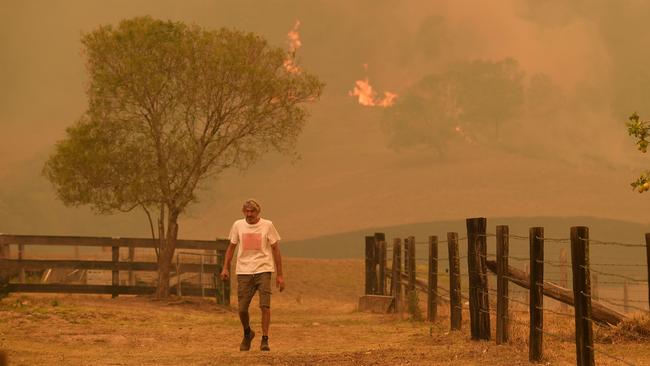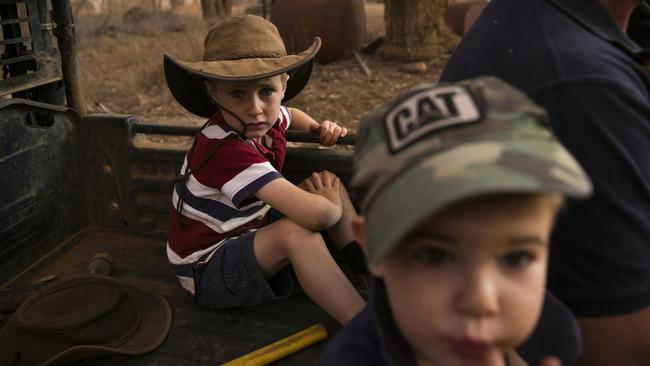Drought’s grip extends to coast as crucial rivers and dams run dry
Critical water shortages plaguing country towns are now threatening hundreds of thousands of people who live in coastal areas of NSW, with crucial rivers and dams run set to run dry within weeks.
- Firefighters banned from RFS waterbombing aircraft
- Bushfire crisis forces drought-hit towns to truck water in
The drought that has wreaked havoc inland has spread to the coast, as rivers and dams that supply major seaside cities and towns will run completely dry within weeks.
Critical water shortages of the same magnitude as those plaguing country towns are now threatening hundreds of thousands of people who live far from the dusty and cracked earth of western NSW.
New official government “Day Zero” projections, obtained by The Sunday Telegraph, reveal the dates when crucial rivers and dams that supply drinking water to coastal centres are expected to run dry without significant and unlikely rainfall or emergency intervention.

The first major coastal town whose river won’t be able to supple water is Bellingen on the far north coast.
The Bellinger River catchment, one of the state’s wettest and most reliable river catchments; reached record low flows in early November and is predicted to completely dry up by early January.
When the Bellinger River stops, the 12,700 residents of Bellingen, Urunaga, and nearby villages will drink bore water from an underground aquifer until a portable desalination plant can be installed.
In the worst-case scenario, assuming long-range forecasts are correct and there is no significant rain on the horizon, homes and businesses in and around the major centre of Taree on the mid north coast will lose flowing fresh water from the Manning River in February.
In addition to emergency bores, pipelines and portable desalination plants already under construction near Taree, the local council will pipe treated sewage to dairy and poultry businesses and suck water out of a nearby mine and limestone quarry.

Rainfall is likely to be below average in NSW until at least March and into early Autumn and it is very likely to be hotter than average, according to the Bureau of Meteorology.
Without a dramatic turnaround in the climate, there is less than a year’s worth of flowing water left for the coastal city Port Macquarie.
Port Macquarie’s peril has been exacerbated by the nearby town of Wauchope tapping into dam water because it couldn’t rely on the rapidly drying Hastings River.
Even Newcastle has been given its D-Day — June 2021.
The problem is not isolated to the north coast, as the intensifying drought on the South Coast means Batemans Bay has between six and 12 months of fresh water left.
How Aussie prehistoric beasts became extinct
Even as their truck melted, this brave RFS crew fought on

Farmers in the normally lush South Coast town of Bega, known for its green pasture and dairy production, will be denied access to water for irrigation within months to shore up town supply.
“As we have seen elsewhere across NSW, drought conditions have turned conventional wisdom on its head,” WaterNSW executive manager Adrian Langdon said.
“We face the prospect of imposing restrictions on general security (water for irrigation) within months if the drought conditions aren’t alleviated by inflows generated by significant rain.”
The Brogo Dam near Bega on the South Coast, which is typically blessed by high rainfall and comparatively low demand, has fallen from 100 per cent to just 39 per cent in six months.
Farmers at Casino, known as the “beef capital of Australia” also face being cut off from river water early next year, after the Kyogle Dam inland from Byron Bay dropped from 95 per cent to 33 per cent this year.

Stopgap measures have extended “day zero” dates in western NSW, where rivers have stopped flowing but safe drinking water still flows from the tap – albeit salty to taste or feeling “slippery” to bathe in because of high bicarbonate levels.
Residents in major western cities Dubbo, Warren, Nyngan and Cobar are still drinking after the Macquarie River was stopped with a temporary weir and the water was diverted to towns.
Pumps will drain out the dregs remaining in the Burrendong Dam – below the zero per cent mark – which will shore up supply for the central and north western towns until at least the middle of next year.
Another river, the Peel River that supplies Tamworth’s drinking water, was stopped on Monday and water from the Chaffey Dam is being piped into town to stop seepage and evaporation.
Tamworth was going to run out of water in June, but after the emergency intervention the city’s water supply will last until 2021.
FARMER’S WIFE FASHIONS A LIVING
On a desolate farm in central NSW, a young mother-of-three has launched a fashion label that has blossomed since it appeared on a social media site supporting rural businesses in drought-ravaged areas.
The “Buy From The Bush” grassroots campaign, which has attracted more than 139,000 followers on Instagram and Facebook since it launched seven weeks ago, plugs businesses like Annabelle Kennedy’s children’s fashion brand Kennedy The Label.
The exposure flooded Ms Kennedy’s online store with orders, forcing her to drive the 150-kilometre round trip to the post office every day just to keep up with demand.

It’s a glimmer of hope for the Kennedys, whose enormous 161 square-kilometre farm is nothing but dust. The family spend $15,000 a week — $780,000 a year — feeding their 5500 remaining breeding sheep.
“The farm is completely desolate, it looks like the Sahara, there’s not a blade of grass in sight and there hasn’t been for at least the past 12 months,” she said
Kennedy The Label started in 2012 as a passion project and to keep Ms Kennedy occupied, after moving from Sydney to the outback to marry her childhood sweetheart.
The side hustle has become the family’s only income while the drought stretches on. On Thursday, 20 business owners from the bush, including Ms Kennedy, will display their wares at a pop-up market in Martin Place.



